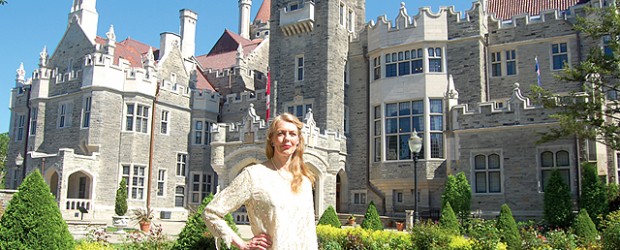Casa Loma: New keepers at the gate
JULY 4, 2011POSTED IN Toronto Today: Original Article

By OMAR MOSLEH
Trelawny Howell sits on a lawn chair behind Toronto’s castle on the hill, decked out in a flowing beige dress with immaculately styled hair and makeup. She looks as out of place among the casually attired students and tourists as does the department store patio set against the grand backdrop of the Edwardian-era castle.
The chairs, she comments, were added only recently, at her insistence.
A direct descendant of Mary Pellatt, wife of the man who built Casa Loma, Howell is not a fan of the caretaking job done by the Kiwanis Club of Casa Loma, the organization that managed Toronto’s second most popular attraction for the past 74 years.
“They seem to only add things when it’s demanded of them,” she says incredulously.
She believes her great uncle’s former casa has been allowed to crumble.
“It’s very, very badly managed (and) it always has been,” she says, with a steely gaze that gives the distinct impression she’s about ready to storm the castle’s gates. “They’ve badly represented Sir Henry Pellatt.”
Pellatt, a financier who made his name in bringing hydro electricity to Toronto, had Casa Loma built in 1914 for Mary. At the time, it was the largest private residence in Canada. The government seized the home in 1933 to compensate for thousands owed in back taxes.
Howell has a long list of grievances in regard to the castle’s current state.
Among them: Casa Loma has no working elevator, no air conditioning and only four bathrooms available to the public. The hardwood floors are tarnished and there are no new exhibits, except for a mysterious closed-off stairwell that bears scrawled graffiti.
But today the Kiwanis Club is no longer king of the castle. The City of Toronto has negotiated management rights from the club.
The city decided against renewing its contract with the Kiwanis Club upon discovering that, in addition to generating no meaningful profit from the castle, the service club was actually losing money, says Michael Williams, the city’s general manager of Economic Development and Culture.
“It became clear that the business climate for managing something like the castle had changed,” Williams said in a telephone interview. “Kiwanis does not have the money to reinvest in the interior, nor does the city.
“A new solution has to be found.”
The city has now created Casa Loma Corporation to manage the castle for a transitional period of 12–18 months, while a new revenue model is being created. As part of the arrangement with the Kiwanis Club the city will pay $1.45 million for artifacts and trademarks.
The changeover officially took place in a city council vote on June 14.
While Casa Loma is no longer literally crumbling, thanks to a $20 million exterior restoration project initiated by the city, many would agree the attraction is now a mere shell of its former glory.
“Everyone knows, feels and understands that this is an unpolished gem in the city of Toronto,” says Ward 21 councillor Joe Mihevc. “It’s kind of like the elephant in the room, that everyone knows and appreciates and drives by, but they’re not seized by it.
“We need to discover the spark.”
But how, exactly, does one set a spark to a nearly 100-year-old castle? Ideas to revitalize the attraction have been proposed, but so far nothing is set in stone.
One oft-criticized issue with Casa Loma’s revenue model is that there are no rotating exhibits to give Torontonians incentive for repeat visits.
“At the moment it’s really what I call a one-time visit location — it’s static,” Williams said. “The only reason you would come a second or third time is if you’re bringing someone from out of town.”
Mihevc said he hopes new life will be breathed into several underutilized spaces, such as the balcony.
While there is a confectionary stand in the basement on the side, “there’s no high tea on the balcony,” Mihevc noted.
“It has one of the most gorgeous views in the city and we’re not leveraging that.”
He also said the stables, just north of Austin Terrace, are practically empty, despite being open to the public.
“The stables are really gorgeous, and acoustically very pleasant,” he said. “It would be nice to partner with some kind of arts organization to have an ongoing schedule of special events.”
Howell has several ideas of her own, including a lunch or supper club that could be held in partnership with the nearby George Brown College culinary school.
“It would be fantastic for them to showcase their food exhibits and have luncheons,” she suggested. “In general, the food could be phenomenal, at all levels.”
Currently the castle has a deli in the basement, but guests cannot take food or drink upstairs or out into the garden.
Howell also figures the wine cellar could be an attractive place to visit.
“Why not have wine sampling down there and promote Ontario wines?” she asked. “Sir Henry Pellatt had the biggest wine cellar that existed in the city at the time, and they’ve sort of just closed and blocked it off.”
Casa Loma Corporation does not plan to change much in the short term, but Williams did say one consideration is moving the gift shop from the basement to make it more visible to the public.
The city will eventually conduct a special study and seek public consultation on how to rejuvenate the castle.
“We need the public to dream anew as to what the castle could be,” Mihevc said.
Howell says she is happy the city now has the keys to the castle, but believes there is still a long way to go.
“The castle needs a spiritual cleansing, but who knows what will happen,” she remarked. “This play is still playing out.”